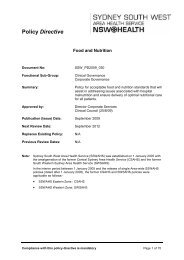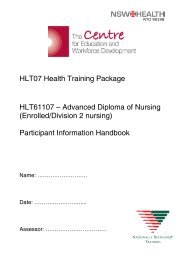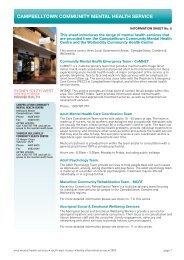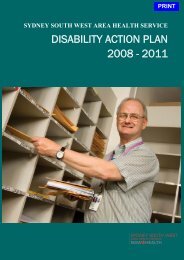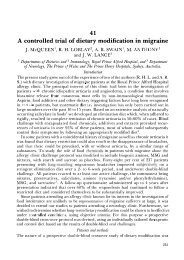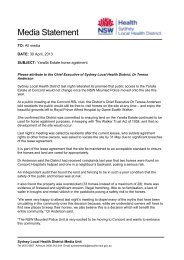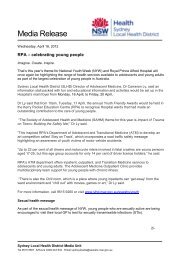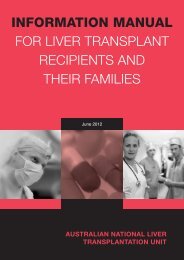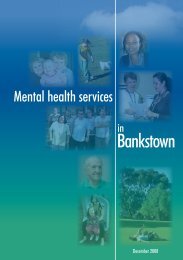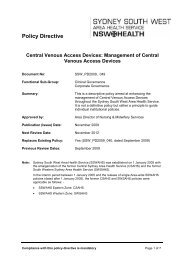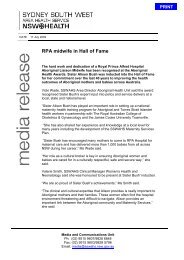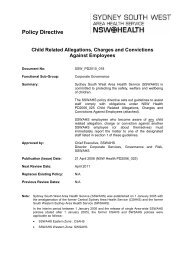Aged Care & Rehabilitation Clinical Services Plan 2007 – 2012
Aged Care & Rehabilitation Clinical Services Plan 2007 – 2012
Aged Care & Rehabilitation Clinical Services Plan 2007 – 2012
Create successful ePaper yourself
Turn your PDF publications into a flip-book with our unique Google optimized e-Paper software.
<strong>Aged</strong> <strong>Care</strong> & <strong>Rehabilitation</strong> <strong>Clinical</strong> Service <strong>Plan</strong> <strong>2007</strong> - <strong>2012</strong>assistance with medication within the Unit during the day. A review of the impact on other serviceswould be required after a period of time. Ideally the unit would offer a home-like atmosphere withprivate bedrooms and a shared bathroom, kitchen and living area, thus enabling the patient to returnto activities of daily living at the earliest possible time within the continuum of care. The length ofstay in such a unit would be anticipated as ranging between two weeks and two months, dependingon the circumstances of the patient.The benefits will be reduced length of stay in the acute Burns Unit, reduced dependency andinstitutionalisation effects resulting from long periods of hospitalisation, increased empowerment toenable a person to take control of their activities of daily living, and to start to socialise andreconnect with their families in a more homely environment.Where practical, patients should then be transferred to receive outpatient services from their localhospital if possible.Recommendation – Burns <strong>Rehabilitation</strong>Contingent on the outcomes of the state-wide planning for Burns <strong>Services</strong>, establish a four bedBurns Step Down Unit at CRGH in the style of a transitional living unit, supported by noninpatientservices7.3 Non-Traumatic Spinal Cord Injury <strong>Rehabilitation</strong>Acute spinal cord injury (SCI) services are based at Prince of Wales and Royal North ShoreHospitals. These services also offer specialist SCI rehabilitation, predominantly for people withtraumatic SCIs. SSWAHS manages patients with a non-traumatic SCI in general rehabilitationwards.7.3.1 Current and Emerging Issues• Increasing prevalence – particularly associated with population ageing;• Expertise required – there is particular expertise required to meet the needs of peoplewith non-traumatic SCI’s, including the need for close relationships with neurology,urology and plastics services;• Interaction with traumatic spinal cord injury services – existing outreach therapyservices associated with traumatic SCI services are unable to meet the demand;7.3.2 Future Model of <strong>Care</strong>Patients with a non-traumatic SCI and those requiring post-acute spinal injury rehabilitation shouldbe managed in a single unit for SSWAHS. An inpatient unit should be established to provide thisservice, ideally located on a site with access to neurology, urology and plastics services. Theestablishment of a dedicated unit would require a higher level of nursing and allied health expertiseto provide the required care for this group of patients. Additional outpatient clinics and non-inpatienttherapy services are also required to support this service. Specialised spinal cord injury outpatienttherapy services would facilitate the maintenance of gains made through the inpatient episode andfurther improvement of functioning and independence in the community.Recommendation – Non-Traumatic Spinal Cord Injury <strong>Rehabilitation</strong>Subject to the outcomes of state-wide planning for Spinal Cord Injury <strong>Services</strong>, investigate thedevelopment of a 14 bed non-traumatic spinal cord injury / post-acute injury rehabilitation unitwithin SSWAHS, supported by outpatient and non-inpatient therapy servicesPage 60




